Aboriginal and Torres Strait Islander Culture: USQ Essay Analysis
VerifiedAdded on 2023/01/19
|6
|1631
|44
Essay
AI Summary
This essay delves into the Aboriginal and Torres Strait Islander cultures, contrasting their worldviews with those of Western societies. It highlights the Aboriginals' deep connection to nature, land, and spirituality, which sharply contrasts with the Western emphasis on human dominance, scientific skepticism, and materialistic values. The essay explores the frustrations arising from these cultural clashes, particularly the loss of control over land and the impact on their way of life, including challenges related to health, education, and cultural preservation. It analyzes how governmental policies and language barriers exacerbate these issues, leading to distrust and hindering communication. The conclusion emphasizes the significant and enduring challenges faced by Aboriginals due to these differing perspectives, especially the cross-cultural and language barriers.
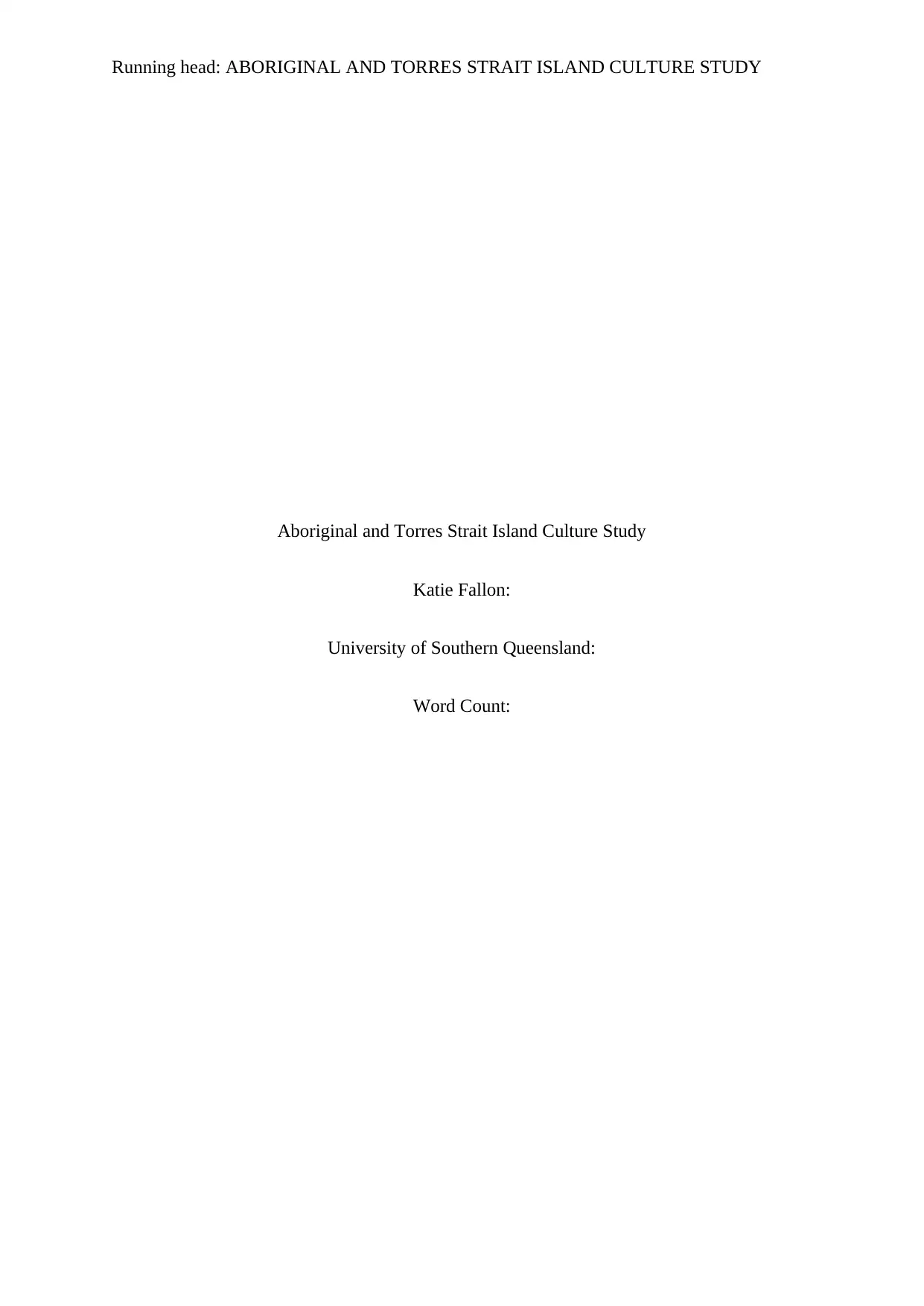
Running head: ABORIGINAL AND TORRES STRAIT ISLAND CULTURE STUDY
Aboriginal and Torres Strait Island Culture Study
Katie Fallon:
University of Southern Queensland:
Word Count:
Aboriginal and Torres Strait Island Culture Study
Katie Fallon:
University of Southern Queensland:
Word Count:
Paraphrase This Document
Need a fresh take? Get an instant paraphrase of this document with our AI Paraphraser
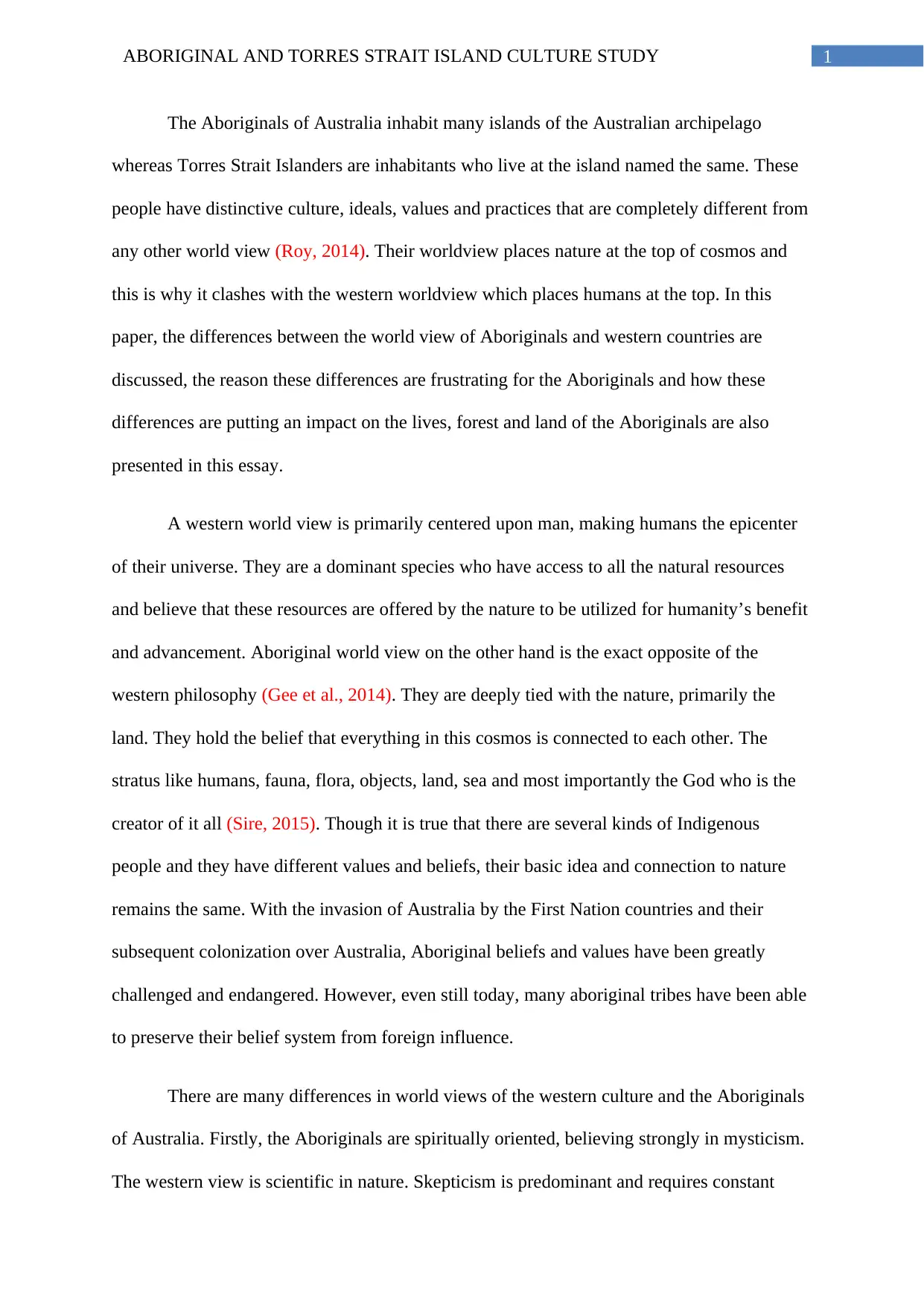
1ABORIGINAL AND TORRES STRAIT ISLAND CULTURE STUDY
The Aboriginals of Australia inhabit many islands of the Australian archipelago
whereas Torres Strait Islanders are inhabitants who live at the island named the same. These
people have distinctive culture, ideals, values and practices that are completely different from
any other world view (Roy, 2014). Their worldview places nature at the top of cosmos and
this is why it clashes with the western worldview which places humans at the top. In this
paper, the differences between the world view of Aboriginals and western countries are
discussed, the reason these differences are frustrating for the Aboriginals and how these
differences are putting an impact on the lives, forest and land of the Aboriginals are also
presented in this essay.
A western world view is primarily centered upon man, making humans the epicenter
of their universe. They are a dominant species who have access to all the natural resources
and believe that these resources are offered by the nature to be utilized for humanity’s benefit
and advancement. Aboriginal world view on the other hand is the exact opposite of the
western philosophy (Gee et al., 2014). They are deeply tied with the nature, primarily the
land. They hold the belief that everything in this cosmos is connected to each other. The
stratus like humans, fauna, flora, objects, land, sea and most importantly the God who is the
creator of it all (Sire, 2015). Though it is true that there are several kinds of Indigenous
people and they have different values and beliefs, their basic idea and connection to nature
remains the same. With the invasion of Australia by the First Nation countries and their
subsequent colonization over Australia, Aboriginal beliefs and values have been greatly
challenged and endangered. However, even still today, many aboriginal tribes have been able
to preserve their belief system from foreign influence.
There are many differences in world views of the western culture and the Aboriginals
of Australia. Firstly, the Aboriginals are spiritually oriented, believing strongly in mysticism.
The western view is scientific in nature. Skepticism is predominant and requires constant
The Aboriginals of Australia inhabit many islands of the Australian archipelago
whereas Torres Strait Islanders are inhabitants who live at the island named the same. These
people have distinctive culture, ideals, values and practices that are completely different from
any other world view (Roy, 2014). Their worldview places nature at the top of cosmos and
this is why it clashes with the western worldview which places humans at the top. In this
paper, the differences between the world view of Aboriginals and western countries are
discussed, the reason these differences are frustrating for the Aboriginals and how these
differences are putting an impact on the lives, forest and land of the Aboriginals are also
presented in this essay.
A western world view is primarily centered upon man, making humans the epicenter
of their universe. They are a dominant species who have access to all the natural resources
and believe that these resources are offered by the nature to be utilized for humanity’s benefit
and advancement. Aboriginal world view on the other hand is the exact opposite of the
western philosophy (Gee et al., 2014). They are deeply tied with the nature, primarily the
land. They hold the belief that everything in this cosmos is connected to each other. The
stratus like humans, fauna, flora, objects, land, sea and most importantly the God who is the
creator of it all (Sire, 2015). Though it is true that there are several kinds of Indigenous
people and they have different values and beliefs, their basic idea and connection to nature
remains the same. With the invasion of Australia by the First Nation countries and their
subsequent colonization over Australia, Aboriginal beliefs and values have been greatly
challenged and endangered. However, even still today, many aboriginal tribes have been able
to preserve their belief system from foreign influence.
There are many differences in world views of the western culture and the Aboriginals
of Australia. Firstly, the Aboriginals are spiritually oriented, believing strongly in mysticism.
The western view is scientific in nature. Skepticism is predominant and requires constant
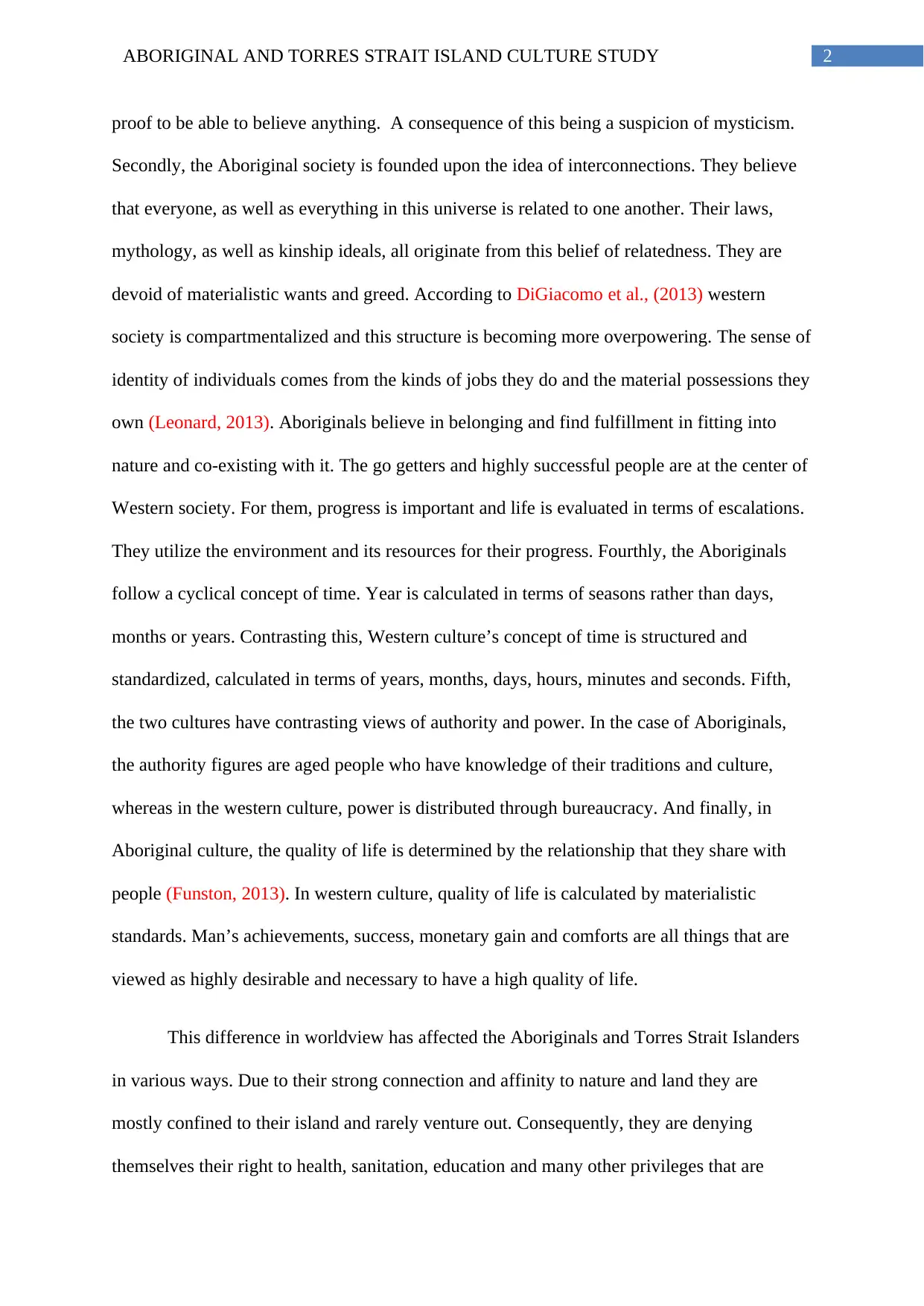
2ABORIGINAL AND TORRES STRAIT ISLAND CULTURE STUDY
proof to be able to believe anything. A consequence of this being a suspicion of mysticism.
Secondly, the Aboriginal society is founded upon the idea of interconnections. They believe
that everyone, as well as everything in this universe is related to one another. Their laws,
mythology, as well as kinship ideals, all originate from this belief of relatedness. They are
devoid of materialistic wants and greed. According to DiGiacomo et al., (2013) western
society is compartmentalized and this structure is becoming more overpowering. The sense of
identity of individuals comes from the kinds of jobs they do and the material possessions they
own (Leonard, 2013). Aboriginals believe in belonging and find fulfillment in fitting into
nature and co-existing with it. The go getters and highly successful people are at the center of
Western society. For them, progress is important and life is evaluated in terms of escalations.
They utilize the environment and its resources for their progress. Fourthly, the Aboriginals
follow a cyclical concept of time. Year is calculated in terms of seasons rather than days,
months or years. Contrasting this, Western culture’s concept of time is structured and
standardized, calculated in terms of years, months, days, hours, minutes and seconds. Fifth,
the two cultures have contrasting views of authority and power. In the case of Aboriginals,
the authority figures are aged people who have knowledge of their traditions and culture,
whereas in the western culture, power is distributed through bureaucracy. And finally, in
Aboriginal culture, the quality of life is determined by the relationship that they share with
people (Funston, 2013). In western culture, quality of life is calculated by materialistic
standards. Man’s achievements, success, monetary gain and comforts are all things that are
viewed as highly desirable and necessary to have a high quality of life.
This difference in worldview has affected the Aboriginals and Torres Strait Islanders
in various ways. Due to their strong connection and affinity to nature and land they are
mostly confined to their island and rarely venture out. Consequently, they are denying
themselves their right to health, sanitation, education and many other privileges that are
proof to be able to believe anything. A consequence of this being a suspicion of mysticism.
Secondly, the Aboriginal society is founded upon the idea of interconnections. They believe
that everyone, as well as everything in this universe is related to one another. Their laws,
mythology, as well as kinship ideals, all originate from this belief of relatedness. They are
devoid of materialistic wants and greed. According to DiGiacomo et al., (2013) western
society is compartmentalized and this structure is becoming more overpowering. The sense of
identity of individuals comes from the kinds of jobs they do and the material possessions they
own (Leonard, 2013). Aboriginals believe in belonging and find fulfillment in fitting into
nature and co-existing with it. The go getters and highly successful people are at the center of
Western society. For them, progress is important and life is evaluated in terms of escalations.
They utilize the environment and its resources for their progress. Fourthly, the Aboriginals
follow a cyclical concept of time. Year is calculated in terms of seasons rather than days,
months or years. Contrasting this, Western culture’s concept of time is structured and
standardized, calculated in terms of years, months, days, hours, minutes and seconds. Fifth,
the two cultures have contrasting views of authority and power. In the case of Aboriginals,
the authority figures are aged people who have knowledge of their traditions and culture,
whereas in the western culture, power is distributed through bureaucracy. And finally, in
Aboriginal culture, the quality of life is determined by the relationship that they share with
people (Funston, 2013). In western culture, quality of life is calculated by materialistic
standards. Man’s achievements, success, monetary gain and comforts are all things that are
viewed as highly desirable and necessary to have a high quality of life.
This difference in worldview has affected the Aboriginals and Torres Strait Islanders
in various ways. Due to their strong connection and affinity to nature and land they are
mostly confined to their island and rarely venture out. Consequently, they are denying
themselves their right to health, sanitation, education and many other privileges that are
⊘ This is a preview!⊘
Do you want full access?
Subscribe today to unlock all pages.

Trusted by 1+ million students worldwide
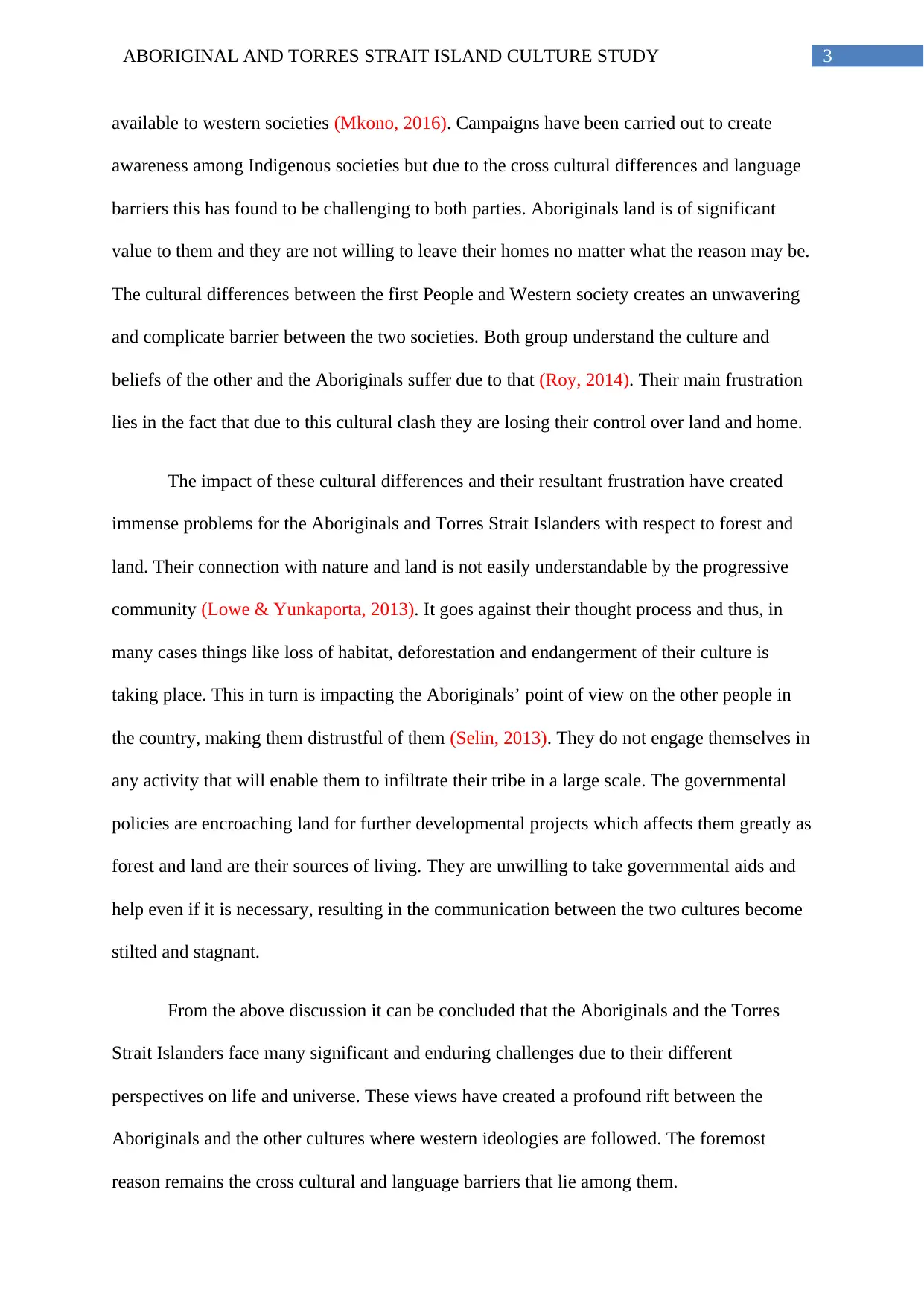
3ABORIGINAL AND TORRES STRAIT ISLAND CULTURE STUDY
available to western societies (Mkono, 2016). Campaigns have been carried out to create
awareness among Indigenous societies but due to the cross cultural differences and language
barriers this has found to be challenging to both parties. Aboriginals land is of significant
value to them and they are not willing to leave their homes no matter what the reason may be.
The cultural differences between the first People and Western society creates an unwavering
and complicate barrier between the two societies. Both group understand the culture and
beliefs of the other and the Aboriginals suffer due to that (Roy, 2014). Their main frustration
lies in the fact that due to this cultural clash they are losing their control over land and home.
The impact of these cultural differences and their resultant frustration have created
immense problems for the Aboriginals and Torres Strait Islanders with respect to forest and
land. Their connection with nature and land is not easily understandable by the progressive
community (Lowe & Yunkaporta, 2013). It goes against their thought process and thus, in
many cases things like loss of habitat, deforestation and endangerment of their culture is
taking place. This in turn is impacting the Aboriginals’ point of view on the other people in
the country, making them distrustful of them (Selin, 2013). They do not engage themselves in
any activity that will enable them to infiltrate their tribe in a large scale. The governmental
policies are encroaching land for further developmental projects which affects them greatly as
forest and land are their sources of living. They are unwilling to take governmental aids and
help even if it is necessary, resulting in the communication between the two cultures become
stilted and stagnant.
From the above discussion it can be concluded that the Aboriginals and the Torres
Strait Islanders face many significant and enduring challenges due to their different
perspectives on life and universe. These views have created a profound rift between the
Aboriginals and the other cultures where western ideologies are followed. The foremost
reason remains the cross cultural and language barriers that lie among them.
available to western societies (Mkono, 2016). Campaigns have been carried out to create
awareness among Indigenous societies but due to the cross cultural differences and language
barriers this has found to be challenging to both parties. Aboriginals land is of significant
value to them and they are not willing to leave their homes no matter what the reason may be.
The cultural differences between the first People and Western society creates an unwavering
and complicate barrier between the two societies. Both group understand the culture and
beliefs of the other and the Aboriginals suffer due to that (Roy, 2014). Their main frustration
lies in the fact that due to this cultural clash they are losing their control over land and home.
The impact of these cultural differences and their resultant frustration have created
immense problems for the Aboriginals and Torres Strait Islanders with respect to forest and
land. Their connection with nature and land is not easily understandable by the progressive
community (Lowe & Yunkaporta, 2013). It goes against their thought process and thus, in
many cases things like loss of habitat, deforestation and endangerment of their culture is
taking place. This in turn is impacting the Aboriginals’ point of view on the other people in
the country, making them distrustful of them (Selin, 2013). They do not engage themselves in
any activity that will enable them to infiltrate their tribe in a large scale. The governmental
policies are encroaching land for further developmental projects which affects them greatly as
forest and land are their sources of living. They are unwilling to take governmental aids and
help even if it is necessary, resulting in the communication between the two cultures become
stilted and stagnant.
From the above discussion it can be concluded that the Aboriginals and the Torres
Strait Islanders face many significant and enduring challenges due to their different
perspectives on life and universe. These views have created a profound rift between the
Aboriginals and the other cultures where western ideologies are followed. The foremost
reason remains the cross cultural and language barriers that lie among them.
Paraphrase This Document
Need a fresh take? Get an instant paraphrase of this document with our AI Paraphraser
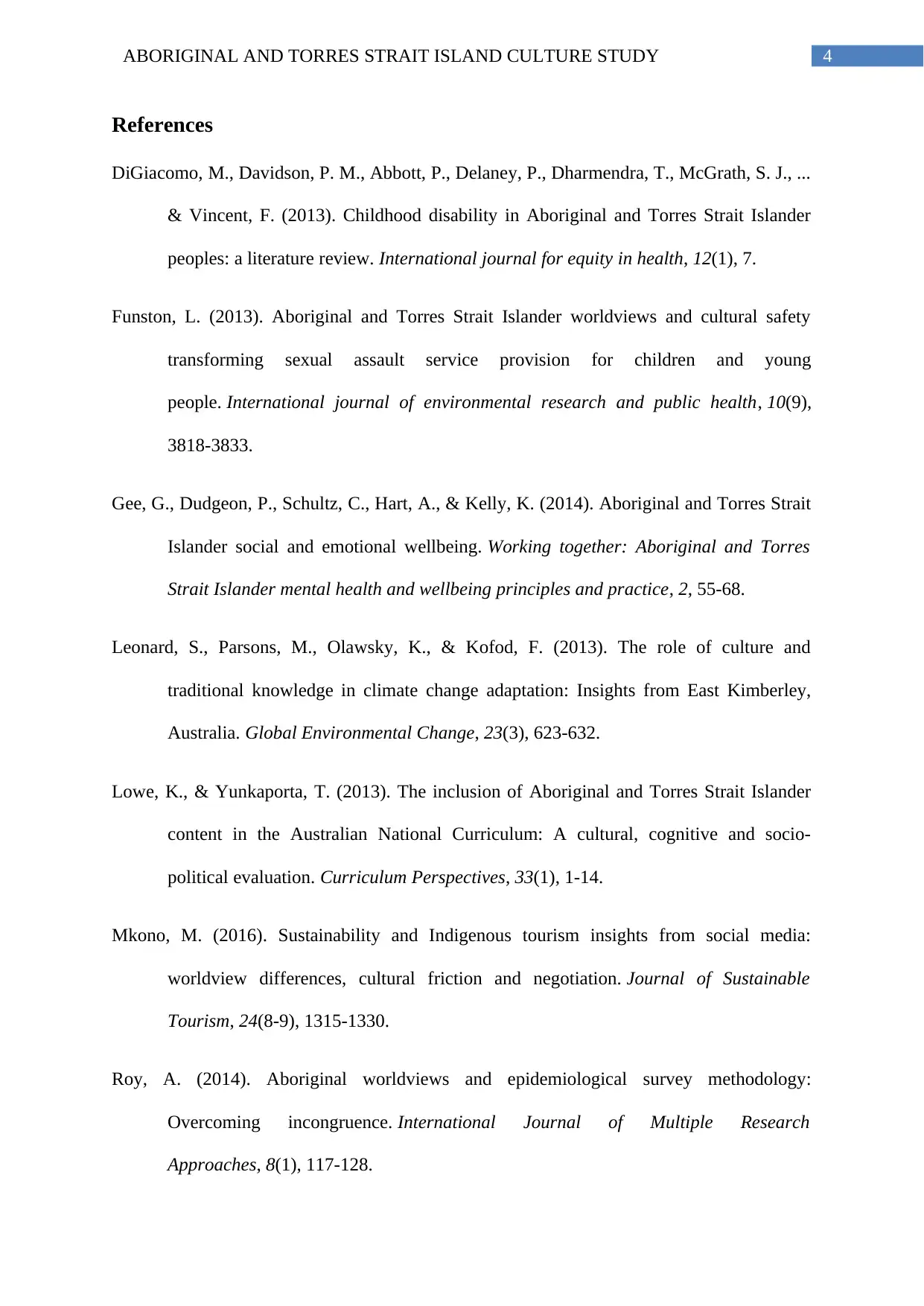
4ABORIGINAL AND TORRES STRAIT ISLAND CULTURE STUDY
References
DiGiacomo, M., Davidson, P. M., Abbott, P., Delaney, P., Dharmendra, T., McGrath, S. J., ...
& Vincent, F. (2013). Childhood disability in Aboriginal and Torres Strait Islander
peoples: a literature review. International journal for equity in health, 12(1), 7.
Funston, L. (2013). Aboriginal and Torres Strait Islander worldviews and cultural safety
transforming sexual assault service provision for children and young
people. International journal of environmental research and public health, 10(9),
3818-3833.
Gee, G., Dudgeon, P., Schultz, C., Hart, A., & Kelly, K. (2014). Aboriginal and Torres Strait
Islander social and emotional wellbeing. Working together: Aboriginal and Torres
Strait Islander mental health and wellbeing principles and practice, 2, 55-68.
Leonard, S., Parsons, M., Olawsky, K., & Kofod, F. (2013). The role of culture and
traditional knowledge in climate change adaptation: Insights from East Kimberley,
Australia. Global Environmental Change, 23(3), 623-632.
Lowe, K., & Yunkaporta, T. (2013). The inclusion of Aboriginal and Torres Strait Islander
content in the Australian National Curriculum: A cultural, cognitive and socio-
political evaluation. Curriculum Perspectives, 33(1), 1-14.
Mkono, M. (2016). Sustainability and Indigenous tourism insights from social media:
worldview differences, cultural friction and negotiation. Journal of Sustainable
Tourism, 24(8-9), 1315-1330.
Roy, A. (2014). Aboriginal worldviews and epidemiological survey methodology:
Overcoming incongruence. International Journal of Multiple Research
Approaches, 8(1), 117-128.
References
DiGiacomo, M., Davidson, P. M., Abbott, P., Delaney, P., Dharmendra, T., McGrath, S. J., ...
& Vincent, F. (2013). Childhood disability in Aboriginal and Torres Strait Islander
peoples: a literature review. International journal for equity in health, 12(1), 7.
Funston, L. (2013). Aboriginal and Torres Strait Islander worldviews and cultural safety
transforming sexual assault service provision for children and young
people. International journal of environmental research and public health, 10(9),
3818-3833.
Gee, G., Dudgeon, P., Schultz, C., Hart, A., & Kelly, K. (2014). Aboriginal and Torres Strait
Islander social and emotional wellbeing. Working together: Aboriginal and Torres
Strait Islander mental health and wellbeing principles and practice, 2, 55-68.
Leonard, S., Parsons, M., Olawsky, K., & Kofod, F. (2013). The role of culture and
traditional knowledge in climate change adaptation: Insights from East Kimberley,
Australia. Global Environmental Change, 23(3), 623-632.
Lowe, K., & Yunkaporta, T. (2013). The inclusion of Aboriginal and Torres Strait Islander
content in the Australian National Curriculum: A cultural, cognitive and socio-
political evaluation. Curriculum Perspectives, 33(1), 1-14.
Mkono, M. (2016). Sustainability and Indigenous tourism insights from social media:
worldview differences, cultural friction and negotiation. Journal of Sustainable
Tourism, 24(8-9), 1315-1330.
Roy, A. (2014). Aboriginal worldviews and epidemiological survey methodology:
Overcoming incongruence. International Journal of Multiple Research
Approaches, 8(1), 117-128.
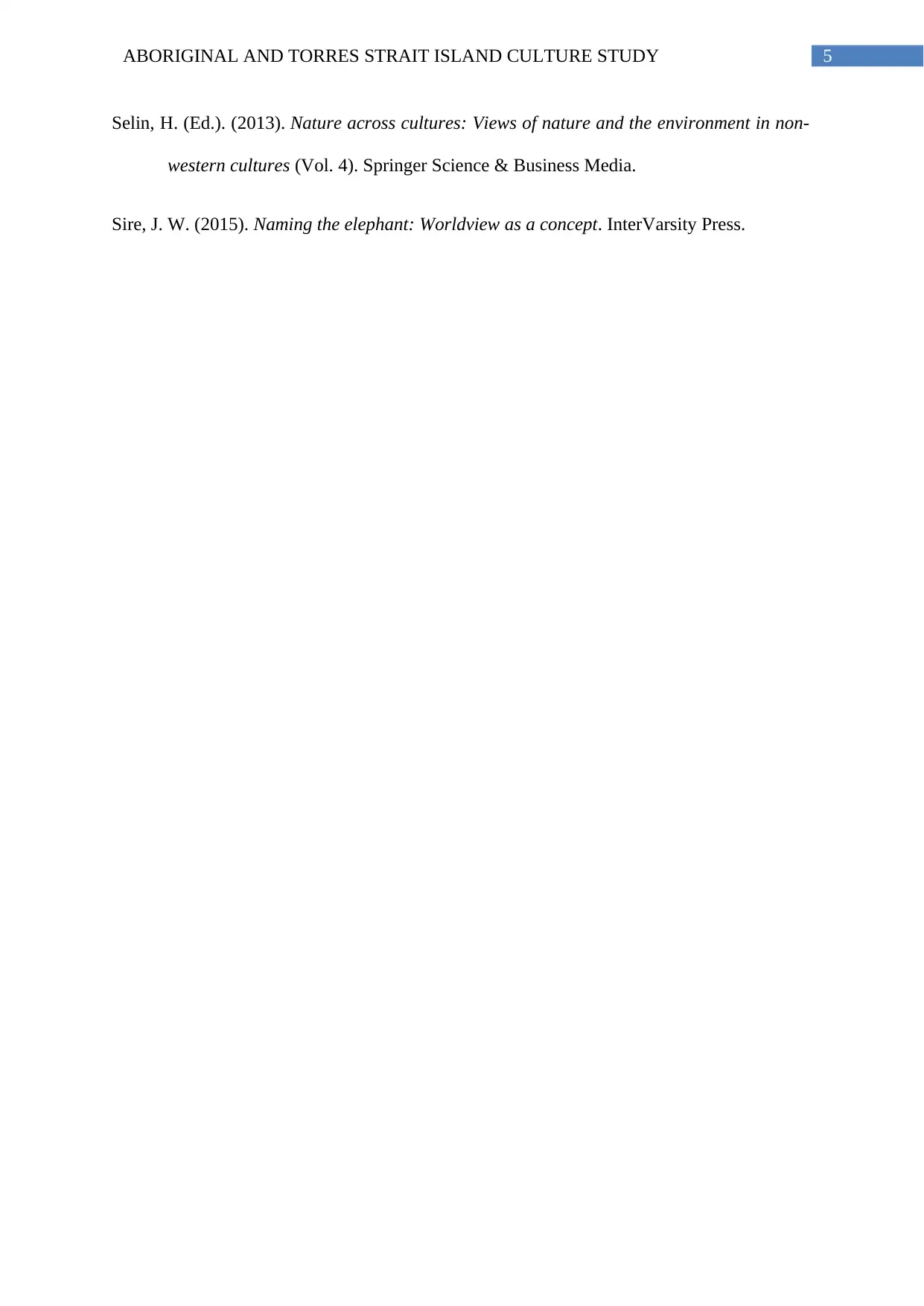
5ABORIGINAL AND TORRES STRAIT ISLAND CULTURE STUDY
Selin, H. (Ed.). (2013). Nature across cultures: Views of nature and the environment in non-
western cultures (Vol. 4). Springer Science & Business Media.
Sire, J. W. (2015). Naming the elephant: Worldview as a concept. InterVarsity Press.
Selin, H. (Ed.). (2013). Nature across cultures: Views of nature and the environment in non-
western cultures (Vol. 4). Springer Science & Business Media.
Sire, J. W. (2015). Naming the elephant: Worldview as a concept. InterVarsity Press.
⊘ This is a preview!⊘
Do you want full access?
Subscribe today to unlock all pages.

Trusted by 1+ million students worldwide
1 out of 6
Related Documents
Your All-in-One AI-Powered Toolkit for Academic Success.
+13062052269
info@desklib.com
Available 24*7 on WhatsApp / Email
![[object Object]](/_next/static/media/star-bottom.7253800d.svg)
Unlock your academic potential
Copyright © 2020–2025 A2Z Services. All Rights Reserved. Developed and managed by ZUCOL.





